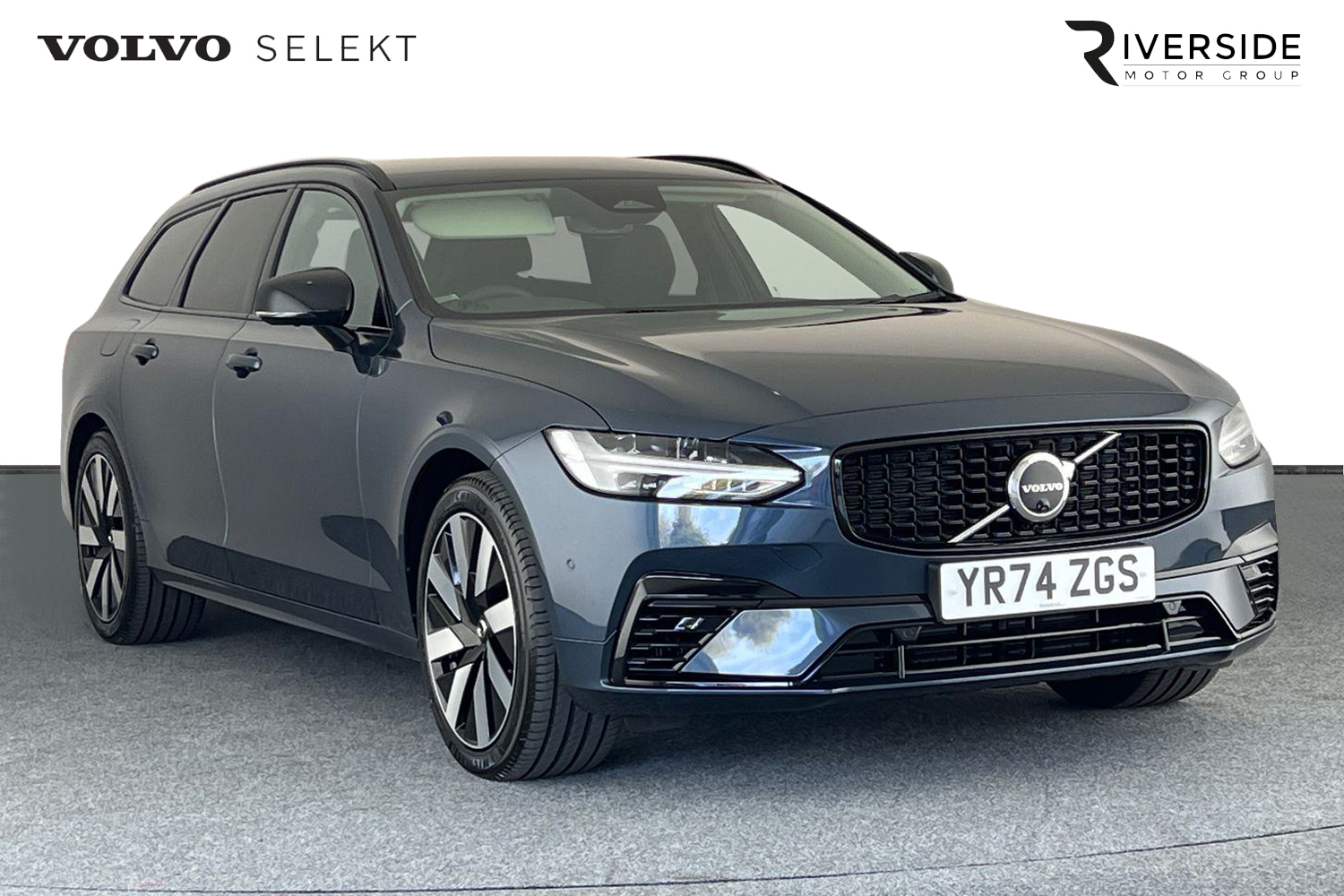Used Volvo V90 for sale: everything you need to know
In 2023, Volvo announced it would no longer be selling estate cars in the UK. It felt like the end of an institution, as Volvo’s boxy (and occasionally not so boxy) wagons have been a common sight on the roads for decades, but the rise and rise of the SUV means most people are choosing those instead.
That doesn’t mean the V90 plays second best to cars like the Volvo XC90 though, as Volvo’s levels of safety and equipment are as high as ever, and the V90 is probably one of the most handsome shapes on the road. It’s still spacious and accommodating, and Volvo’s push towards hybrid technology means it’s economical too, if not the most exciting car in its class to drive.
If you do want slightly more engaging driving dynamics then cars like the BMW 5 Series Touring, Jaguar XF Sportbrake, and Mercedes-Benz E-Class Estate remain the ones to beat, while Volvo certainly doesn’t have a monopoly on estate car space any more - the Skoda Superb Estate actually offers greater luggage room.
Should you buy a Volvo V90?
Every brand has its core model, a car that explains everything you need to know about the maker’s cars, wrapped up in a single package. For BMW, it’s the 3 Series. For Mazda, it’s the MX-5 sports car. And for Volvo, it’s the V90 - a car that encapsulates the Volvo brand’s focus on safety, comfort, and above all, the practicality of an estate car.
Volvo’s focus is moving towards SUVs in the coming years but the V90 remains an example of what the Swedish brand does best. The well-proportioned, modern shape hides a spacious and comfortable interior and a sizeable boot, but also clothes all Volvo’s latest safety knowledge and technology, and a range of fuel-efficient drivetrains.
The V90 has always been quite expensive to buy, but this makes used models very appealing indeed, with cars only a few years old costing half of what they did when new yet lacking little in terms of features or ability compared to the most recent cars. In-car technology has improved over time (based around the same 9-inch central portrait touchscreen) which is worth bearing in mind, particularly as Apple CarPlay has only recently been made available (and Android Auto still isn’t).
The V90’s cabin is comfortable and refined, only spoiled slightly by the ride quality on models with larger wheels, which doesn’t quite have the isolation from the road that might have convinced you to look at a Volvo over something like a BMW 5-Series Touring. It’s not as good to drive as the BMW in general, though that’s unlikely to disappoint most buyers. Strangely though, luggage space might: despite being a large car, it doesn’t have the largest boot in this class.
That honour goes to the Skoda Superb, one of the cars you might consider instead, thanks to its massive 660 litre boot with the rear seats in place. The German alternatives - the Audi A6 Avant, BMW 5-Series Touring, and Mercedes-Benz E-Class Estate - are all practical too and offer varying levels of driver engagement, interior quality, features, and comfort, while the Jaguar XF Sportbrake drives well too, and actually just tops the V90 for boot space, at 565 litres.
A Volvo V90 not for you? We've got 1000s of used cars for sale to suit all budgets and needs.
What’s the best used Volvo V90 model to buy?
While Volvo dropped diesel from its range a few years back, D4 and D5 versions of the Volvo V90 are still easy to find in the used market and as is ever the case with diesel, makes sense for drivers who tend to travel longer distances - despite the petrol B4 and B5’s mild hybrid tech, the diesels still have claimed economy around 10mpg better, and will be in their element on the motorway.
The B4 and B5 are still frugal for their size though and very refined, so they’re still easy to recommend. If you have somewhere to charge, the plug-in hybrid Recharge models also make sense, since Volvo claims an EV range of more than 45 miles on both the T6 and T8, which should cover almost all shorter daily trips without using a drop of fuel. As they’re expensive new, they probably make more sense at softer used prices too. No V90 is badly equipped, so you don’t need to shy away from even the lower trim levels.
Used Volvo V90 fuel economy and performance
- Volvo V90 D4: Volvo dropped its diesel models after 2020. The starting point used to be the D4, with front wheel drive only and a 190PS output, good for 0-62mph in 8.5 seconds. Combined economy went up to 57.6mpg with the smallest wheel options.
- Volvo V90 D5: D5 models still used a 2-litre four-cylinder diesel unit but offered more power at 235PS, and had all-wheel drive. 0-62mph took 7.2 seconds, and Volvo claimed up to 50.4mpg combined.
- Volvo V90 B4: Several years back Volvo slimmed down its entire range to a selection of 2-litre petrol four-cylinder in various states of tuning. In the B4 it makes 197PS and drives the front wheels through an automatic gearbox. 0-62mph comes up in 7.9 seconds and claimed economy is up to 40.3mpg.
- Volvo V90 B5: The same petrol unit makes a little more power in B5 form at 250PS, and takes a second from the B4’s 0-62mph time, at 6.9 seconds. Economy drops slightly to 39.7mpg combined.
- Volvo V90 T6 Recharge: The plug-in hybrid Recharge models are once again based around a 2-litre four-cylinder petrol, but both are all-wheel drive. The T6 makes 253PS and has a 5.5-second 0-62mph time, gets between 256.5 and 352.6mpg in the WLTP tests, and has a claimed EV range of 46-54 miles.
- Volvo V90 T8 Recharge: In 310PS form the T8 Recharge goes from 0-62mph in only 4.8 seconds. Economy, in the lab if not the real world, is between 256.5 to 313.4mpg, with an EV range of between 46-52 miles according to Volvo.
What used Volvo V90 trim levels are available?
With the Volvo V90 going off sale soon in the UK, the company has slimmed down its range of available trim lines to just two models, which we’ve covered in detail below, though the V90 has previously been offered in several other trim lines since it debuted in 2017, so equipment levels have varied significantly over the years.
- The Volvo V90 Plus is where the most recent Volvo V90 model line kicks off. All V90s as a minimum include keyless go, LED headlights, two-zone climate control, cruise control, and heated front seats, to which Plus spec adds 19-inch alloy wheels, a 360-degree parking camera, 13-speaker audio, and a heated windscreen.
- The Volvo V90 Ultimate upgrades to adaptive dampers, 20-inch alloys, a head-up display, 18-speaker audio, and a powered panoramic sunroof.
- While the variants above represent the car in its most recent specification, you’ll also see several other models on the used market. Volvo has previously offered Momentum, R-Design, Inscription, and Cross Country models, serving as entry-level, sporty, more luxurious, and off-road oriented versions respectively, with the Cross Country most distinctive of these thanks to its raised ride height and body cladding. You may also see Pro variants of the first three which typically added features such as larger wheels, keyless go, heated washer jets and a heated steering wheel, and a head-up display.
Used Volvo V90 dimensions and boot size
The Volvo V90’s dimensions are:
- Length: 4945mm
- Width: 1895mm (mirrors folded), 2019mm (with mirrors)
- Height: 1478mm
The Volvo V90’s boot size is:
- 551 litres
- 904 litres with the rear seats folded (1517 litres to roof)
Used Volvo V90 road tax
Most Volvo V90 models have hit the road since April 2017 so are subject to a flat rate of VED or ‘road tax’, which currently stands at £180 per year for non-hybrids and £170 a year for the hybrid versions, which are classed as ‘alternative fuel vehicles’. That said, if the car is in its second to sixth year of registration and cost more than £40,000 new (which will apply to several V90s), it’s subject to a surcharge, lifting the annual bill to £570 for the petrol and diesel models and £560 for the hybrids.
How much is it to insure a Volvo V90?
The Volvo V90 is unlikely to be cheap to insure, but its insurance group ratings aren’t unusual for a car of its size and expense. A petrol B4 in Plus trim starts in group 33 (out of 50), rising to group 42 for a T8 in Ultimate trim. For comparison, an equivalent BMW 520i SE Touring starts at group 35, while a 530e M Sport Touring roughly equivalent to the T8 Ultimate sits in group 41.
Read our full Volvo V90 review


